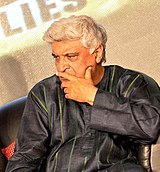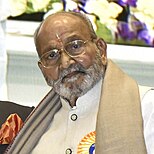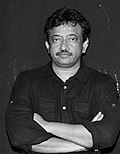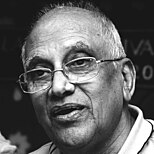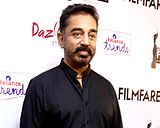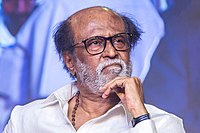
A | B | C | D | E | F | G | H | CH | I | J | K | L | M | N | O | P | Q | R | S | T | U | V | W | X | Y | Z | 0 | 1 | 2 | 3 | 4 | 5 | 6 | 7 | 8 | 9
| Cinema of India | |
|---|---|
 | |
| No. of screens | 9,382 (2022)[1] |
| • Per capita | 6 per million (2021)[2] |
| Produced feature films (2021–22)[3] | |
| Total | 2886 |
| Number of admissions (2016)[4] | |
| Total | 2,020,000,000 |
| • Per capita | 1.69 |
| National films | 1,713,600,000 |
| Gross box office (2022)[7] | |
| Total | ₹15,000 crore[5] |
| National films | $3.7 billion (2020)[6] |
| Part of a series on the |
| Culture of India |
|---|
 |
The Cinema of India, consisting of motion pictures made by the Indian film industry, has had a large effect on world cinema since 2nd half of 20th century.[8][9] Indian cinema is made up of various film industries, including Hindi cinema, which makes motion pictures in the Hindi language and is one of the biggest film industries in the country.[9][10] In 2021, Telugu cinema became the largest film industry in India in terms of box-office.[11][10] Major centers of film production across the country include Mumbai,Chennai, Hyderabad, Kolkata, Kochi, Bangalore, Bhubaneswar-Cuttack and Guwahati.[details 1] For a number of years the Indian film industry has ranked first in the world in terms of annual film output.[31] In 2022, Indian cinema earned ₹15,000 crore ($1.7955 billion) at the box-office.[5]
Indian cinema is composed of multilingual and multi-ethnic film art. In 2022, Hindi cinema represented 33% of box office revenue, followed by Telugu representing 20%, Tamil representing 16%, Kannada representing 8% and Malayalam representing 6%.[32] Other prominent film industries are that of Bengali, Marathi, Odia, Punjabi, Gujarati and Bhojpuri.[32] As of 2022, the combined revenue of South Indian film industries have surpassed that of the Mumbai-based Hindi-language film industry (Bollywood).[33][34] As of 2022, Telugu cinema leads Indian cinema's box-office revenue.[35][36][10]
Indian cinema is a global enterprise[37] and its films have attracted international attention and acclaim throughout South Asia.[38] Since the inception of Indian cinema in 1913, Hindi cinema enjoyed the position of top film industry, but in recent years other industries started giving tough competition to it.[39] Overseas Indians account for 12% of revenue for the industry.[40] Major film production houses in India are Arka Media Works, UV Creations, Aashirvad Cinemas, AGS Entertainment, Ajay Devgn FFilms, AVM Productions, Dharma Productions, Eros International, Geetha Arts, Hombale Films, Lyca Productions, Modern Theatres, Reliance Entertainment, Red Chillies Entertainment, Mythri Movie Makers, Salman Khan Films, Sun Pictures, Suresh Productions, UTV Motion Pictures, Yash Raj Films and Zee Entertainment Enterprises.
History
The history of cinema in India extends to the beginning of the film era. Following the screening of the Lumière and Robert Paul moving pictures in London in 1896, commercial cinematography became a worldwide sensation and these films were shown in Bombay (now Mumbai) that same year.[41]
Silent era (1890s–1920s)
In 1897, a film presentation by filmmaker Professor Stevenson featured a stage show at Calcutta's Star Theatre. With Stevenson's camera and encouragement, Indian photographer Hiralal Sen filmed scenes from that show, exhibited as The Flower of Persia (1898).[42] The Wrestlers (1899), by H. S. Bhatavdekar, showing a wrestling match at the Hanging Gardens in Bombay, was the first film to be shot by an Indian and the first Indian documentary film.[citation needed] From 1913 to 1931, all the movies made in India were silent films, which had no sound and had intertitles.[43]
|
|
|
In 1913, Dadasaheb Phalke released Raja Harishchandra (1913) in Bombay, the first film made in India. It was a silent film incorporating Marathi and English intertitles.[48] It was premiered in Coronation cinema in Girgaon.[49]
Although some claim Shree Pundalik (1912) of Dadasaheb Torne is the first ever film made in India.[50][51][49] Some film scholars have argued that Pundalik was not a true Indian film because it was simply a recording of a stage play, filmed by a British cameraman and it was processed in London.[52][53][48] Raja Harishchandra of Phalke had a story based on Hindu Sanskrit legend of Harishchandra, a truthful King and its success led many to consider him a pioneer of Indian cinema.[49] Phalke used an all Indian crew including actors Anna Salunke and D. D. Dabke. He directed, edited, processed the film himself.[48] Phalke saw The Life of Christ (1906) by the French director Alice Guy-Blaché, While watching Jesus on the screen, Phalke envisioned Hindu deities Rama and Krishna instead and decided to start in the business of "moving pictures".[54]
In South India, film pioneer Raghupathi Venkayya, credited as the father of Telugu cinema, built the first cinemas in Madras (now Chennai), and a film studio was established in the city by Nataraja Mudaliar.[55][56][57]
The first Tamil and Malayam films, also silent films, were Keechaka Vadham (1917–1918, R. Nataraja Mudaliar)[58] and Vigathakumaran (1928, J. C. Daniel Nadar). The latter was the first Indian social drama film and featured the first Dalit-caste film actress.[citation needed]
The first chain of Indian cinemas, Madan Theatre, was owned by Parsi entrepreneur Jamshedji Framji Madan, who oversaw the production and distribution of films for the chain.[49] These included film adaptations from Bengal's popular literature and Satyawadi Raja Harishchandra (1917), a remake of Phalke's influential film.[citation needed]
Films steadily gained popularity across India as affordable entertainment for the masses (admission as low as an anna in Bombay).[41] Young producers began to incorporate elements of Indian social life and culture into cinema, others brought new ideas from across the world. Global audiences and markets soon became aware of India's film industry.[59]
In 1927, the British government, to promote the market in India for British films over American ones, formed the Indian Cinematograph Enquiry Committee. The ICC consisted of three British and three Indians, led by T. Rangachari, a Madras lawyer.[60] This committee failed to bolster the desired recommendations of supporting British Film, instead recommending support for the fledgling Indian film industry, and their suggestions were set aside.
Sound era
The first Indian sound film was Alam Ara (1931) made by Ardeshir Irani.[49] Ayodhyecha Raja (1932) was the first sound film of Marathi cinema.[43] Irani also produced South India's first sound film, the Tamil–Telugu bilingual talking picture Kalidas (1931, H. M. Reddy).[61][62]
The first Telugu film with audible dialogue, Bhakta Prahlada (1932), was directed by H. M. Reddy, who directed the first bilingual (Telugu and Tamil) talkie Kalidas (1931).[63] East India Film Company produced its first Telugu film, Savitri (1933, C. Pullaiah), adapted from a stage play by Mylavaram Bala Bharathi Samajam.[64] The film received an honorary diploma at the 2nd Venice International Film Festival.[65] Chittoor Nagayya was one of the first multilingual filmmakers in India.[66][67]
Jumai Shasthi was the first Bengali talkie.[citation needed]
Jyoti Prasad Agarwala made his first film Joymoti (1935) in Assamese, and later made Indramalati.[citation needed] The first film studio in South India, Durga Cinetone, was built in 1936 by Nidamarthi Surayya in Rajahmundry, Andhra Pradesh.[68][contradictory] The advent of sound to Indian cinema launched musicals such as Indra Sabha and Devi Devyani, marking the beginning of song-and-dance in Indian films.[49] By 1935, studios emerged in major cities such as Madras, Calcutta and Bombay as filmmaking became an established industry, exemplified by the success of Devdas (1935).[69] The first colour film made in India was Kisan Kanya (1937, Moti B).[70] Viswa Mohini (1940) was the first Indian film to depict the Indian movie-making world.[71]
Swamikannu Vincent, who had built the first cinema of South India in Coimbatore, introduced the concept of "tent cinema" in which a tent was erected on a stretch of open land to screen films. The first of its kind was in Madras and called Edison's Grand Cinema Megaphone. This was due to the fact that electric carbons were used for motion picture projectors.[72][further explanation needed] Bombay Talkies opened in 1934 and Prabhat Studios in Pune began production of Marathi films.[69] Sant Tukaram (1936) was the first Indian film to be screened at an international film festival,[contradictory] at the 1937 edition of the Venice Film Festival. The film was judged one of the three best films of the year.[73] However, while Indian filmmakers sought to tell important stories, the British Raj banned Wrath (1930) and Raithu Bidda (1938) for broaching the subject of the Indian independence movement.[49][74][75]
The Indian Masala film—a term used for mixed-genre films that combined song, dance, romance, etc.—arose following the Second World War.[69] During the 1940s, cinema in South India accounted for nearly half of India's cinema halls, and cinema came to be viewed as an instrument of cultural revival.[69] The Indian People's Theatre Association (IPTA), an art movement with a communist inclination, began to take shape through the 1940s and the 1950s.[76] IPTA plays, such as Nabanna (1944), prepared the ground for realism in Indian cinema, exemplified by Khwaja Ahmad Abbas's Dharti Ke Lal (Children of the Earth, 1946).[76] The IPTA movement continued to emphasise realism in films Mother India (1957) and Pyaasa (1957), among India's most recognisable cinematic productions.[77]
Following independence, the 1947 partition of India divided the nation's assets and a number of studios moved to Pakistan.[69] Partition became an enduring film subject thereafter.[69] The Indian government had established a Films Division by 1948, which eventually became one of the world's largest documentary film producers with an annual production of over 200 short documentaries, each released in 18 languages with 9,000 prints for permanent film theatres across the country.[78]
Golden Age (late 1940s–1960s)
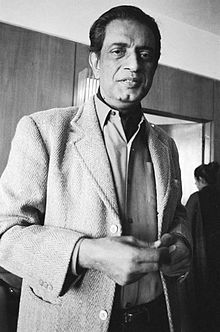
The period from the late 1940s to the early 1960s is regarded by film historians as the Golden Age of Indian cinema.[85][86][87] This period saw the emergence of the Parallel Cinema movement, which emphasised social realism. Mainly led by Bengalis,[88] early examples include Dharti Ke Lal (1946, Khwaja Ahmad Abbas),[89] Neecha Nagar (1946, Chetan Anand),[90] Nagarik (1952, Ritwik Ghatak)[91][92] and Do Bigha Zamin (1953, Bimal Roy), laying the foundations for Indian neorealism[93]
The Apu Trilogy (1955–1959, Satyajit Ray) won prizes at several major international film festivals and firmly established the Parallel Cinema movement.[94] It was influential on world cinema and led to a rush of coming-of-age films in art house theatres.[95] Cinematographer Subrata Mitra developed the technique of bounce lighting, to recreate the effect of daylight on sets, during the second film of the trilogy[96] and later pioneered other effects such as the photo-negative flashbacks and X-ray digressions.[97]
During the 1950s, Indian cinema reportedly became the world's second largest film industry, earning a gross annual income of ₹250 million (equivalent to ₹26 billion or US$330 million in 2023) in 1953.[98] The government created the Film Finance Corporation (FFC) in 1960 to provide financial support to filmmakers.[99] While serving as Information and Broadcasting Minister of India in the 1960s, Indira Gandhi supported the production of off-beat cinema through the FFC.[99]
Commercial Hindi cinema began thriving, including acclaimed films Pyaasa (1957) and Kaagaz Ke Phool (1959, Guru Dutt) Awaara (1951) and Shree 420 (1955, Raj Kapoor). These films expressed social themes mainly dealing with working-class urban life in India; Awaara presented Bombay as both a nightmare and a dream, while Pyaasa critiqued the unreality of city life.[88]
Epic film Mother India (1957, Mehboob Khan) was the first Indian film to be nominated for the US-based Academy of Motion Picture Arts and Sciences' Academy Award for Best Foreign Language Film[100] and defined the conventions of Hindi cinema for decades.[101][102][103] It spawned a new genre of dacoit films.[104] Gunga Jumna (1961, Dilip Kumar) was a dacoit crime drama about two brothers on opposite sides of the law, a theme that became common in Indian films in the 1970s.[105] Madhumati (1958, Bimal Roy) popularised the theme of reincarnation in Western popular culture.[106]
Actor Dilip Kumar rose to fame in the 1950s, and was the biggest Indian movie star of the time.[107][108] He was a pioneer of method acting, predating Hollywood method actors such as Marlon Brando. Much like Brando's influence on New Hollywood actors, Kumar inspired Indian actors, including Amitabh Bachchan, Naseeruddin Shah, Shah Rukh Khan and Nawazuddin Siddiqui.[109]
Neecha Nagar (1946) won the Palme d'Or at Cannes[90] and Indian films competed for the award most years in the 1950s and early 1960s.[citation needed] Ray is regarded as one of the greatest auteurs of 20th century cinema,[110] along with his contemporaries Dutt[111] and Ghatak.[112] In 1992, the Sight & Sound Critics' Poll ranked Ray at No. 7 in its list of Top 10 Directors of all time.[113] Multiple films from this era are included among the greatest films of all time in various critics' and directors' polls, including The Apu Trilogy,[114] Jalsaghar, Charulata[115] Aranyer Din Ratri,[116] Pyaasa, Kaagaz Ke Phool, Meghe Dhaka Tara, Komal Gandhar, Awaara, Baiju Bawra, Mother India, Mughal-e-Azam[117] and Subarnarekha (also tied at No. 11).[112]
Sivaji Ganesan became India's first actor to receive an international award when he won the Best Actor award at the Afro-Asian film festival in 1960 and was awarded the title of Chevalier in the Legion of Honour by the French Government in 1995.[118] Tamil cinema is influenced by Dravidian politics,[119] with prominent film personalities C N Annadurai, M G Ramachandran, M Karunanidhi and Jayalalithaa becoming Chief Ministers of Tamil Nadu.[120][timeframe?]
1970s–present
By 1986, India's annual film output had increased to 833 films annually, making India the world's largest film producer.[121] Hindi film production of Bombay, the largest segment of the industry, became known as "Bollywood".
By 1996, the Indian film industry had an estimated domestic cinema viewership of 600 million people, establishing India as one of the largest film markets, with the largest regional industries being Hindi, Telugu, and Tamil films.[122] In 2001, in terms of ticket sales, Indian cinema sold an estimated 3.6 billion tickets annually across the globe, compared to Hollywood's 2.6 billion tickets sold.[123][124]
Hindi
Realistic Parallel Cinema continued throughout the 1970s,[125] practised in many Indian film cultures. The FFC's art film orientation came under criticism during a Committee on Public Undertakings investigation in 1976, which accused the body of not doing enough to encourage commercial cinema.[126]
Hindi commercial cinema continued with films such as Aradhana (1969), Sachaa Jhutha (1970), Haathi Mere Saathi (1971), Anand (1971), Kati Patang (1971) Amar Prem (1972), Dushman (1972) and Daag (1973).[importance?]
By the early 1970s, Hindi cinema was experiencing thematic stagnation,[129] dominated by musical romance films.[130] Screenwriter duo Salim–Javed (Salim Khan and Javed Akhtar) revitalised the industry.[129] They established the genre of gritty, violent, Bombay underworld crime films with Zanjeer (1973) and Deewaar (1975).[131][132] They reinterpreted the rural themes of Mother India and Gunga Jumna in an urban context reflecting 1970s India,[129][133] channelling the growing discontent and disillusionment among the masses,[129] unprecedented growth of slums[134] and urban poverty, corruption and crime,[135] as well as anti-establishment themes.[136] This resulted in their creation of the "angry young man", personified by Amitabh Bachchan,[136] who reinterpreted Kumar's performance in Gunga Jumna[129][133] and gave a voice to the urban poor.[134]
By the mid-1970s, Bachchan's position as a lead actor was solidified by crime-action films Zanjeer and Sholay (1975).[126] The devotional classic Jai Santoshi Ma (1975) was made on a low budget and became a box office success and a cult classic.[126] Another important film was Deewaar (1975, Yash Chopra),[105] a crime film with brothers on opposite sides of the law which Danny Boyle described as "absolutely key to Indian cinema".[137]
The term "Bollywood" was coined in the 1970s,[138][139] when the conventions of commercial Bombay-produced Hindi films were established.[140] Key to this was Nasir Hussain and Salim–Javed's creation of the masala film genre, which combines elements of action, comedy, romance, drama, melodrama and musical.[140][141] Their film Yaadon Ki Baarat (1973) has been identified as the first masala film and the first quintessentially Bollywood film.[140][142] Masala films made Bachchan the biggest Bollywood movie star of the period. Another landmark was Amar Akbar Anthony (1977, Manmohan Desai).[142][143] Desai further expanded the genre in the 1970s and 1980s.
Commercial Hindi cinema grew in the 1980s, with films such as Ek Duuje Ke Liye (1981), Disco Dancer (1982), Himmatwala (1983), Tohfa (1984), Naam (1986), Mr India (1987), and Tezaab (1988).
In the late 1980s,[timeframe?] Hindi cinema experienced another period of stagnation, with a decline in box office turnout, due to increasing violence, decline in musical melodic quality, and rise in video piracy, leading to middle-class family audiences abandoning theatres. The turning point came with Indian blockbuster Disco Dancer (1982) which began the era of disco music in Indian cinema. Lead actor Mithun Chakraborty and music director Bappi Lahiri had the highest number of mainstream Indian hit movies that decade. At the end of the decade, Yash Chopra's Chandni (1989) created a new formula for Bollywood musical romance films, reviving the genre and defining Hindi cinema in the years that followed.[144][145] Commercial Hindi cinema grew in the late 1980s and 1990s, with the release of Mr. India (1987), Qayamat Se Qayamat Tak (1988), Chaalbaaz (1989), Maine Pyar Kiya (1989), Lamhe (1991), Saajan (1991), Khuda Gawah (1992), Khalnayak (1993), Darr (1993),[126] Hum Aapke Hain Koun..! (1994), Dilwale Dulhaniya Le Jayenge (1995), Dil To Pagal Hai (1997), Pyar Kiya Toh Darna Kya (1998) and Kuch Kuch Hota Hai (1998). Cult classic Bandit Queen (1994) directed by Shekhar Kapur received international recognition and controversy.[146][147]
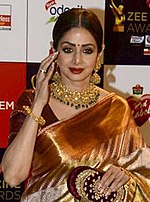
In the late 1990s, there was a resurgence of Parallel Cinema in Bollywood, largely due to the critical and commercial success of crime films such as Satya (1998) and Vaastav (1999). These films launched a genre known as "Mumbai noir",[149] reflecting social problems in the city.[150] Ram Gopal Varma directed the Indian Political Trilogy, and the Indian Gangster Trilogy; film critic Rajeev Masand had labelled the latter series as one of the "most influential movies of Bollywood.[151][152][153] The first instalment of the trilogy, Satya, was also listed in CNN-IBN's 100 greatest Indian films of all time.[154]
Since the 1990s, the three biggest Bollywood movie stars have been the "Three Khans": Aamir Khan, Shah Rukh Khan, and Salman Khan.[155][156] Combined, they starred in the top ten highest-grossing Bollywood films,[155] and have dominated the Indian box office since the 1990s.[157][158] Shah Rukh Khan was the most successful for most of the 1990s and 2000s, while Aamir Khan has been the most successful since the late 2000s;[159] according to Forbes, Shah Rukh Khan is "arguably the world's biggest movie star" as of 2017, due to his immense popularity in India and China.[160] Other notable Hindi film stars of recent decades include Sunny Deol, Akshay Kumar, Ajay Devgn, Hrithik Roshan, Anil Kapoor, Sanjay Dutt, Sridevi, Madhuri Dixit, Aishwarya Rai, Kajol, Tabu, Rani Mukerji and Preity Zinta.
Haider (2014, Vishal Bhardwaj), the third instalment of the Indian Shakespearean Trilogy after Maqbool (2003) and Omkara (2006),[161] won the People's Choice Award at the 9th Rome Film Festival in the Mondo Genere making it the first Indian film to achieve this honour.[162][relevant?]
The 2000s and 2010s also saw the rise of a new generation of popular actors like Shahid Kapoor, Ranbir Kapoor, Ranveer Singh, Ayushmann Khurrana, Varun Dhawan, Sidharth Malhotra, Sushant Singh Rajput, Kartik Aaryan, Arjun Kapoor, Aditya Roy Kapur and Tiger Shroff, as well as actresses like Vidya Balan, Priyanka Chopra, Kareena Kapoor, Katrina Kaif, Kangana Ranaut, Deepika Padukone, Sonam Kapoor, Anushka Sharma, Shraddha Kapoor, Alia Bhatt, Parineeti Chopra and Kriti Sanon with Balan, Ranaut and Bhatt gaining wide recognition for successful female-centric films such as The Dirty Picture (2011), Kahaani (2012), Queen (2014), Highway (2014), Tanu Weds Manu Returns (2015), Raazi (2018) and Gangubai Kathiawadi (2022).
Salim–Javed were highly influential in South Indian cinema. In addition to writing two Kannada films, many of their Bollywood films had remakes produced in other regions, including Tamil, Telugu and Malayalam cinema. While the Bollywood directors and producers held the rights to their films in Northern India, Salim–Javed retained the rights in South India, where they sold remake rights for films such as Zanjeer, Yaadon Ki Baarat and Don.[163] Several of these remakes became breakthroughs for actor Rajinikanth.[130][164]
Sridevi is widely regarded as the first female superstar of Indian cinema due to her pan-Indian appeal with equally successful careers in Hindi, Tamil, Malayalam, Kannada and Telugu cinema. She is the only Bollywood actor to have starred in a top 10 grossing film each year of her active career (1983–1997).[citation needed]
Telugu
Baburao Patel of Filmindia called B. N. Reddy's Malliswari (1951) an "inspiring motion picture" which would "save us the blush when compared with the best of motion pictures of the world".[165] Film historian Randor Guy called Malliswari scripted by Devulapalli Krishnasastri a "poem in celluloid, told with rare artistic finesse, which lingers long in the memory".[166]
K. V. Reddy's Mayabazar (1957) is a landmark film in Indian cinema, a classic of Telugu cinema that inspired generations of filmmakers. It blends myth, fantasy, romance and humor in a timeless story, captivating audiences with its fantastical elements. The film excelled in various departments like cast performances, production design, music, cinematography and is particularly revered for its use of technology.[167][168] The use of special effects, innovative for the 1950s, like the first illusion of moonlight, showcased technical brilliance.. Powerful performances and relatable themes ensure Mayabazar stays relevant, a classic enjoyed by new generations. On the centenary of Indian cinema in 2013, CNN-IBN included Mayabazar in its list of "100 greatest Indian films of all time".[169] In a poll conducted by CNN-IBN among those 100 films, Mayabazar was voted by the public as the "Greatest Indian film of all time."[170]
K. Viswanath's works such as Sankarabharanam (1980) about revitalisation of Indian classical music won the "Prize of the Public" at the Besançon Film Festival of France in the year 1981.[171] Forbes included J. V. Somayajulu's performance in the film on its list of "25 Greatest Acting Performances of Indian Cinema".[172] Swathi Muthyam (1986) was India's official entry to the 59th Academy Awards.[171] Swarna Kamalam (1988) the dance film choreographed by Kelucharan Mohapatra, and Sharon Lowen was featured at the Ann Arbor Film Festival, fetching three Indian Express Awards.[173][174]
B. Narsing Rao, K. N. T. Sastry, and A. Kutumba Rao garnered international recognition for their works in new-wave cinema.[175][176] Narsing Rao's Maa Ooru (1992) won the "Media Wave Award" of Hungary; Daasi (1988) and Matti Manushulu (1990) won the Diploma of Merit awards at the 16th and 17th MIFF respectively.[177][178][179] Sastry's Thilaadanam (2000) received "New Currents Award" at the 7th Busan;[180][181] Rajnesh Domalpalli's Vanaja (2006) won "Best First Feature Award" at the 57th Berlinale.[182][183]
Ram Gopal Varma's Siva (1989), which attained cult following[184] introduced steadicams and new sound recording techniques to Indian films.[185] Siva attracted the young audience during its theatrical run, and its success encouraged filmmakers to explore a variety of themes and make experimental films.[186] Varma introduced road movie and film noir to Indian screen with Kshana Kshanam (1991).[187] Varma experimented with close-to-life performances by the lead actors, which bought a rather fictional storyline a sense of authenticity at a time when the industry was being filled with commercial fillers.[188]
Singeetam Srinivasa Rao introduced science fiction to the Indian screen with Aditya 369 (1991), the film dealt with exploratory dystopian and apocalyptic themes.[189] The edge of the seat thriller had characters which stayed human, inconsistent and insecure. The film's narrative takes the audience into the post apocalyptic experience through time travel, as well as folklore generation of 1500 A.D, including a romantic backstory.Singeetam Srinivasa Rao got inspired from acclaimed Sci-Fi Novel "The Time Machine".[190][191][192]
Chiranjeevi's works such as the social drama film Swayamkrushi (1987), comedy thriller Chantabbai (1986), the vigilante thriller Kondaveeti Donga (1990),[193] the Western thriller Kodama Simham (1990), and the action thriller, Gang Leader (1991), popularised genre films with the highest estimated cinema footfalls.[194] Sekhar Kammula's Dollar Dreams (2000), which explored the conflict between American dreams and human feelings, re-introduced social realism to Telugu film which had stagnated in formulaic commercialism.[195] War drama Kanche (2015, Krish Jagarlamudi) explored the 1944 Nazi attack on the Indian army in the Italian campaign of the Second World War.[196]

Pan-Indian film is a term related to Indian cinema that originated with Telugu cinema as a mainstream commercial film appealing to audiences across the country with a spread to world markets.[199] S. S. Rajamouli pioneered the pan-Indian films movement with duology of epic action films Baahubali: The Beginning (2015) and Baahubali 2: The Conclusion (2017), that changed the face of Indian cinema. Baahubali: The Beginning became the first Indian film to be nominated for American Saturn Awards.[200] It received national and international acclaim for Rajamouli's direction, story, visual effects, cinematography, themes, action sequences, music, and performances, and became a record-breaking box office success.[201] The sequel Baahubali 2 (2017) went on to win the American "Saturn Award for Best International Film" & emerged as the second-highest-grossing Indian film of all time.[202][203]
S.S Rajamouli followed up with the alternate historical film RRR (2022) that received universal critical acclaim for its direction, screenwriting, cast performances, cinematography, soundtrack, action sequences and VFX, which further consolidated the Pan-Indian film market. The film was considered one of the ten best films of the year by the National Board of Review, making it only the seventh non-English language film ever to make it to the list.[204] It also became the first Indian film by an Indian production to win an Academy Award.[205] The film went on to receive several other nominations at the Golden Globe Awards, Critics' Choice Movie Award including Best Foreign Language Film.[206]
Actors like Prabhas, Allu Arjun, Ram Charan and N. T. Rama Rao Jr. enjoy a nationwide popularity among the audiences after the release of their respective Pan-Indian films. Film critics, journalists and analysts, such as Baradwaj Rangan and Vishal Menon, have labelled Prabhas as the "first legit Pan-Indian Superstar".[207]
Tamil
Tamil cinema established Madras (now Chennai) as a secondary film production centre in India, used by Hindi cinema, other South Indian film industries, and Sri Lankan cinema.[208] Over the last quarter of the 20th century, Tamil films from India established a global presence through distribution to an increasing number of overseas theatres.[209][210] The industry also inspired independent filmmaking in Sri Lanka and Tamil diaspora populations in Malaysia, Singapore, and the Western Hemisphere.[211]
Marupakkam (1991, K. S. Sethumadhavan) and Kanchivaram (2007) each won the National Film Award for Best Feature Film.[212] Tamil films receive significant patronage in neighbouring Indian states Kerala, Karnataka, Andhra Pradesh, Maharashtra, Gujarat and New Delhi. In Kerala and Karnataka the films are directly released in Tamil but in Telangana and Andhra Pradesh they are generally dubbed into Telugu.[213][214]
Tamil films have had international success for decades. Since Chandralekha, Muthu was the second Tamil film to be dubbed into Japanese (as Mutu: Odoru Maharaja[215]) and grossed a record $1.6 million in 1998.[216] In 2010, Enthiran grossed a record $4 million in North America.[217] Tamil-language films appeared at multiple film festivals. Kannathil Muthamittal (Ratnam), Veyyil (Vasanthabalan) and Paruthiveeran (Ameer Sultan), Kanchivaram (Priyadarshan) premiered at the Toronto International Film Festival. Tamil films were submitted by India for the Academy Award for Best Foreign Language Film on eight occasions.[218] Chennai-based music composer A. R. Rahaman achieved global recognition with two Academy Awards and is nicknamed as "Isai Puyal" (musical storm) and "Mozart of Madras". Nayakan (1987, Kamal Haasan) was included in Time's All-Time 100 Movies list.[219]
Malayalam
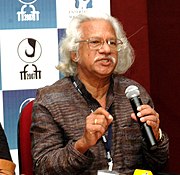
Malayalam cinema experienced its Golden Age during this time with works of filmmakers such as Adoor Gopalakrishnan, G. Aravindan, T. V. Chandran and Shaji N. Karun.[220] Gopalakrishnan is often considered to be Ray's spiritual heir.[221] He directed some of his most acclaimed films during this period, including Elippathayam (1981) which won the Sutherland Trophy at the London Film Festival.[222] In 1984 My Dear Kuttichathan directed by Jijo Punnoose under Navodaya Studio was released and it was the first Indian film to be filmed in 3D format. Karun's debut film Piravi (1989) won the Caméra d'Or at Cannes, while his second film Swaham (1994) was in competition for the Palme d'Or. Vanaprastham was screened at the Un Certain Regard section of the Cannes Film Festival.[223] Murali Nair's Marana Simhasanam (1999), inspired by the first execution by electrocution in India, the film was screened in the Un Certain Regard section at the 1999 Cannes Film Festival where it won the Caméra d'Or.[224][225] The film received special reception at the British Film Institute.[226][227]
Fazil's Manichitrathazhu (1993) scripted by Madhu Muttam; is inspired by a tragedy that happened in an Ezhava tharavad of Alummoottil meda' an old (Traditional house) located at Muttom, Alappuzha district, a central Travancore Channar family, in the 19th century.[228] It was remade in four languages – in Kannada as Apthamitra, in Tamil as Chandramukhi , in Bengali as Rajmohol and in Hindi as Bhool Bhulaiyaa – all being commercially successful.[229] Jeethu Joseph's Drishyam (2013) was remade into four other Indian languages: Drishya (2014) in Kannada, Drushyam (2014) in Telugu, Papanasam (2015) in Tamil and Drishyam (2015) in Hindi. Internationally, it was remade in Sinhala language as Dharmayuddhaya (2017) and in Chinese as Sheep Without a Shepherd (2019), and also in Indonesian.[230][231][232]
Kannada
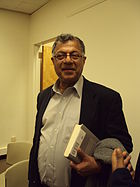

Ethnographic works took prominence such as B. V. Karanth's Chomana Dudi (1975), (based on Chomana Dudi by Shivaram Karanth), Girish Karnad's Kaadu (1973), (based on Kaadu by Srikrishna Alanahalli), Pattabhirama Reddy's Samskara (1970) (based on Samskara by U. R. Ananthamurthy), fetching the Bronze Leopard at Locarno International Film Festival,[233] and T. S. Nagabharana's Mysuru Mallige (based on the works of poet K. S. Narasimhaswamy).[234] Girish Kasaravalli's Ghatashraddha (1977), won the Ducats Award at the Manneham Film Festival Germany,[235] Dweepa (2002), made to Best Film at Moscow International Film Festival,[236][237]
Prashanth Neel's K.G.F (film series) (2018, 2022) is a period action series based on the Kolar Gold Fields.[238] Set in the late 1970s and early 1980s the series follows Raja Krishnappa Bairya aka Rocky (Yash), a Mumbai-based high ranking mercenary born in poverty, to his rise to power in the Kolar Gold Fields and the subsequent uprising as one of the biggest gangster and businessman at that time.[239][240] The film gathered cult following becoming the highest-grossing Kannada film.[241] Rishab Shetty's Kantara (2022), received acclaim for showcasing the Bhoota Kola, a native Ceremonial dance performance prevalent among the Hindus of coastal Karnataka.[242]
Marathi
Marathi cinema also known as Marathi film industry, is a film industry based in Mumbai Maharashtra state. It is the oldest film industry of India. The first Marathi movie, Raja Harishchandra of Dadasaheb Phalke was made in 1912, released in 1913 in Girgaon, it was a silent film with Marathi-English intertitles made with full Marathi actors and crew, after the film emerged successful, Phalke made many movies on Hindu mythology. In 1932, the first sound film, Ayodhyecha Raja was released, just five years after 1st Hollywood sound film The Jazz Singer (1927). The first Marathi film in color made by V Shantaram, Pinjara (1972). In 1960s-70s movies was based on rural, social subjects with drama and humour genre, Nilu Phule was prominent villain that time. In 1980s M. Kothare and Sachin Pilgaonkar made many hit movies on thriller humour and humour genre respectively. Ashok Saraf and Laxmikant Berde starred in many of these and emerged as top actors. Mid 2000s onwards, the industry frequently made hit movies.[43][48][243]
Cultural context
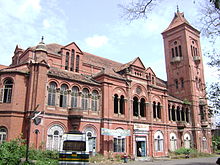

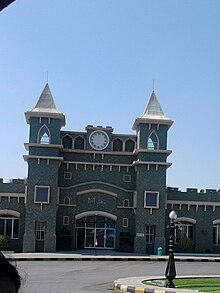
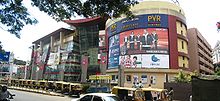
K. Moti Gokulsing and Wimal Dissanayake identified six major influences that have shaped Indian popular cinema:[248]
- The ancient epics of Mahabharata and Ramayana influenced the narratives of Indian cinema. Examples of this influence include the techniques of a side story, back-story and story within a story. Indian popular films often have plots that branch into sub-plots; such narrative dispersals can be seen in the 1993 films Khalnayak and Gardish.
- Ancient Sanskrit drama, with its emphasis on spectacle, music, dance and gesture combined "to create a vibrant artistic unit with dance and mime being central to the dramatic experience". Sanskrit dramas were known as natya, derived from the root word nrit (dance), featuring spectacular dance-dramas.[249] The Rasa method of performance, dating to ancient times, is one of the fundamental features that differentiate Indian from Western cinema. In the Rasa method, the performer conveys emotions to the audience through empathy, in contrast to the Western Stanislavski method where the actor must become "a living, breathing embodiment of a character". The rasa method is apparent in the performances of Hindi actors such as Bachchan and Shah Rukh Khan and in Hindi films such as Rang De Basanti (2006),[250] and Ray's works.[251]
- Traditional folk theatre, which became popular around the 10th century with the decline of Sanskrit theatre. These regional traditions include the Yatra of West Bengal, the Ramlila of Uttar Pradesh, Yakshagana of Karnataka, 'Chindu Natakam' of Andhra Pradesh and the Terukkuttu of Tamil Nadu.
- Parsi theatre, which blends realism and fantasy, containing crude humour, songs and music, sensationalism, and dazzling stagecraft.[249] These influences are clearly evident in masala films such as Coolie (1983), and to an extent in more recent critically acclaimed films such as Rang De Basanti.[250] Zdroj:https://en.wikipedia.org?pojem=Lists_of_Indian_films
Text je dostupný za podmienok Creative Commons Attribution/Share-Alike License 3.0 Unported; prípadne za ďalších podmienok. Podrobnejšie informácie nájdete na stránke Podmienky použitia.
Antropológia
Aplikované vedy
Bibliometria
Dejiny vedy
Encyklopédie
Filozofia vedy
Forenzné vedy
Humanitné vedy
Knižničná veda
Kryogenika
Kryptológia
Kulturológia
Literárna veda
Medzidisciplinárne oblasti
Metódy kvantitatívnej analýzy
Metavedy
Metodika
Text je dostupný za podmienok Creative
Commons Attribution/Share-Alike License 3.0 Unported; prípadne za ďalších
podmienok.
Podrobnejšie informácie nájdete na stránke Podmienky
použitia.
www.astronomia.sk | www.biologia.sk | www.botanika.sk | www.dejiny.sk | www.economy.sk | www.elektrotechnika.sk | www.estetika.sk | www.farmakologia.sk | www.filozofia.sk | Fyzika | www.futurologia.sk | www.genetika.sk | www.chemia.sk | www.lingvistika.sk | www.politologia.sk | www.psychologia.sk | www.sexuologia.sk | www.sociologia.sk | www.veda.sk I www.zoologia.sk






